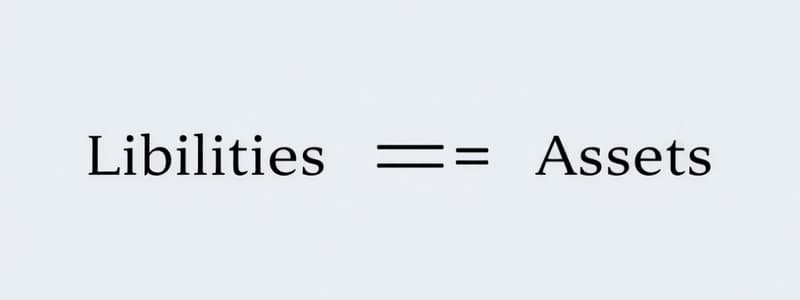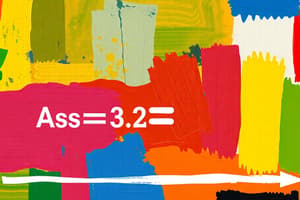Podcast
Questions and Answers
Which of the following best describes the accounting equation?
Which of the following best describes the accounting equation?
- Assets = Capital - Liabilities
- Assets = Capital + Liabilities (correct)
- Assets = Liabilities - Capital
- Assets + Liabilities = Capital
Trade receivables are classified as liabilities in the accounting equation.
Trade receivables are classified as liabilities in the accounting equation.
False (B)
Define 'drawings' in the context of accounting for a sole proprietorship.
Define 'drawings' in the context of accounting for a sole proprietorship.
Drawings are amounts of money or assets taken out of the business by the owner for personal use.
Profits that are retained in a business are accounted for as an ______ to the proprietor's capital.
Profits that are retained in a business are accounted for as an ______ to the proprietor's capital.
Match the following terms with their corresponding definitions:
Match the following terms with their corresponding definitions:
Why is capital invested considered a liability for a business?
Why is capital invested considered a liability for a business?
Paying 'wages' to the proprietor of a business is considered an expense when calculating net profit.
Paying 'wages' to the proprietor of a business is considered an expense when calculating net profit.
What is the effect on the accounting equation when an owner withdraws cash from the business for personal use?
What is the effect on the accounting equation when an owner withdraws cash from the business for personal use?
The historical cost principle states that assets are usually recorded at their ______ when acquired.
The historical cost principle states that assets are usually recorded at their ______ when acquired.
Which of the following is the correct formula for calculating net assets?
Which of the following is the correct formula for calculating net assets?
An increase in net assets always indicates an increase in the capital owed to the owner.
An increase in net assets always indicates an increase in the capital owed to the owner.
Which of the following is an example of a trade payable?
Which of the following is an example of a trade payable?
A customer who buys goods or services on credit is known as a ______.
A customer who buys goods or services on credit is known as a ______.
Explain how the payment of a trade payable affects the accounting equation.
Explain how the payment of a trade payable affects the accounting equation.
When a business earns a profit, the retained profits are accounted for as a reduction in the proprietor's capital.
When a business earns a profit, the retained profits are accounted for as a reduction in the proprietor's capital.
A business purchases equipment on credit. What is the immediate impact on the accounting equation?
A business purchases equipment on credit. What is the immediate impact on the accounting equation?
The term 'account receivables' is used to refer to ______ receivables.
The term 'account receivables' is used to refer to ______ receivables.
Describe the sequence of accounting equation after a company earns profit and owner withdraws some amount.
Describe the sequence of accounting equation after a company earns profit and owner withdraws some amount.
When debt is finally paid, the trade receivable increases assets, 'cash at bank and in hand.
When debt is finally paid, the trade receivable increases assets, 'cash at bank and in hand.
Which of the following is considered as a trade payables?
Which of the following is considered as a trade payables?
Flashcards
Accounting equation
Accounting equation
The accounting equation shows that assets are equal to the sum of liabilities and capital.
Assets
Assets
Resources a business owns, including cash, stall, and goods.
Liabilities
Liabilities
Obligations a business owes to external parties, including capital as a liability to the owner.
Capital
Capital
Signup and view all the flashcards
Retained profits
Retained profits
Signup and view all the flashcards
Drawings
Drawings
Signup and view all the flashcards
Payable/Creditor
Payable/Creditor
Signup and view all the flashcards
Trade payables
Trade payables
Signup and view all the flashcards
Trade receivable/Debtor
Trade receivable/Debtor
Signup and view all the flashcards
Study Notes
- The accounting equation shows the relationship between assets, liabilities, and capital
- Business transactions should restate the equality of assets and liabilities
- Trade payables represent liabilities, while trade receivables represent assets
The Accounting Equation
- Assets = Capital + Liabilities
- A business is a separate entity that owes money to its owner as capital
- In accounting terms, the money value of physical items is their historical cost
Introduced Profit
- Profits made belong to the owners
- Retained profits are an addition to the proprietor's capital
- Net assets equal assets less liabilities
Drawings
- Drawings are amounts of money taken out of a business by its owner
- Accountants treat any amounts paid by a sole trader to its proprietor as drawings, not expenses
- Business suffers a reduction in capital once profits are withdrawn
- Withdrawals of profit are taken in cash, reducing cash assets
- It is important to understand the principles
Trade Payables and Receivables
- A payable is any person or business to whom a business owes money, also known as a creditor
- A payable is a liability of a business
- The term 'account payables' is used to refer to trade payables in the CPA syllabus
- Trade payables are debts from purchasing materials, components, services or goods for resale
- A customer who buys goods without immediate cash payment is a trade receivable
- A trade receivable is often called a debtor and is an asset
- In the CPA syllabus, the term 'account receivables' is used to mean trade receivables
- When a debt is paid, trade receivable asset disappears, replaced by cash
Studying That Suits You
Use AI to generate personalized quizzes and flashcards to suit your learning preferences.




